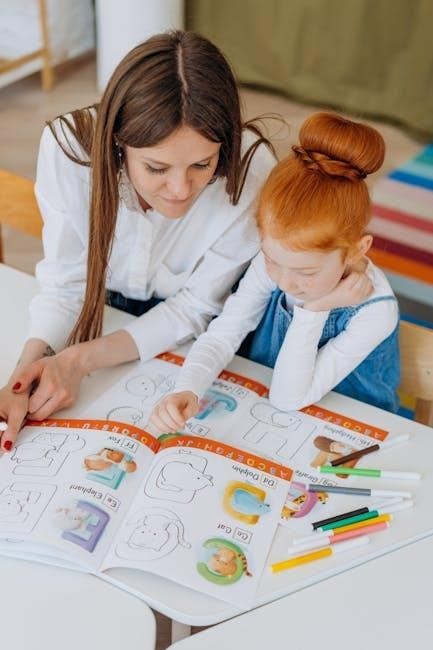
order of teaching phonics letters and sounds pdf
Phonics teaching order systematically introduces letter-sound relationships, ensuring children build reading skills gradually. This structured approach, like the Letters and Sounds Programme, groups letters and sounds strategically to maximize learning efficiency and readability.
- Teaching begins with simple, high-frequency sounds and progresses to more complex patterns.
- Each phase focuses on specific skills, such as blending, segmenting, and applying sounds in words.
- Practise and explicit instruction are key to mastery, ensuring children decode effortlessly and accurately.
What is Phonics?
Phonics is a method of teaching reading and spelling by connecting letters to sounds. It systematically introduces letter-sound relationships, enabling children to decode words. Phonics focuses on the association between sounds and letters, teaching children to blend sounds into words and segment words into sounds. This approach emphasizes explicit instruction, ensuring clarity and consistency in learning. Phonics instruction typically starts with simple, high-frequency sounds and progresses to more complex patterns. It is a foundational skill that supports reading accuracy, fluency, and comprehension. By mastering phonics, children gain the tools to independently read and spell, building a strong literacy foundation.
Importance of Teaching Phonics in a Specific Order
Teaching phonics in a specific order is vital for building foundational reading skills. It ensures children learn letter-sound relationships systematically, starting with simple, high-frequency sounds. This structured approach prevents confusion and supports decoding accuracy. By introducing sounds and letters in a logical sequence, children can blend and segment words effectively. This order also allows teachers to introduce complex patterns gradually, reinforcing previous learning. Consistent progression minimizes knowledge gaps and builds confidence. Phonics taught in a specific order equips children with the tools to read unfamiliar words independently, fostering fluency and comprehension. This method is proven to be effective in developing strong literacy skills from the earliest stages.

Overview of the Letters and Sounds Programme
The Letters and Sounds Programme is a six-phase teaching programme designed to help children understand the relationship between sounds and letters. It introduces basic sounds first, progressing to more complex patterns, providing a clear framework for teaching phonics systematically.
Structure of the Programme
The Letters and Sounds Programme is structured into six phases, each building on the previous one to develop phonics skills systematically. Phase 1 focuses on phonological awareness, while Phases 2-6 introduce letter-sound relationships, blending, and more complex patterns. The programme emphasizes explicit instruction, grouping letters and sounds to maximize learning efficiency. Teaching materials provide a clear order for introducing sounds and letters, along with practice words. The four-part lesson structure—Revisit and Review, Teach, Practise, Apply—ensures consistent and effective instruction. This structured approach helps children progress from decoding simple words to reading complex texts confidently.
Phases of Phonics Teaching
The Letters and Sounds Programme is divided into six phases, each designed to progressively develop phonics skills. Phase 1 focuses on phonological awareness, preparing children to distinguish sounds in spoken language. Phase 2 introduces the first set of letter-sound relationships, teaching children to decode simple words. Phase 3 expands vocabulary by introducing more complex sounds and digraphs. Phase 4 consolidates learning by revisiting sounds and introducing high-frequency words. Phase 5 explores alternative spellings and word families, while Phase 6 refines skills for reading complex texts. Each phase builds on the previous one, ensuring a systematic and structured approach to mastering phonics.

Phase 2: Initial Sounds and Letters
Phase 2 introduces the first set of letter-sound relationships, focusing on simple sounds and letters. Sounds are taught in a specific order, starting with ‘s, a, t, i, p, n,’ to enable children to decode simple three-letter words effectively.
Order of Teaching Sounds in Phase 2
In Phase 2, sounds are taught in a specific order to enable children to decode simple words quickly. The initial sounds introduced are /s/, /a/, /t/, /i/, /p/, and /n/, as these sounds are frequent and form simple three-letter words. Each sound is linked to its corresponding letter, allowing children to blend sounds into words. For example, after learning /s/, /a/, and /t/, children can read “sat.” Sounds are grouped logically to aid blending and segmentation, with daily practise reinforcing these skills. This structured approach ensures children build a strong foundation for reading and spelling.
- Sounds are introduced in a specific sequence to maximize decoding efficiency.
- Each sound is paired with a letter to create simple, recognizable words.
- Practise activities focus on blending and segmenting sounds to form words.
Example Words for Practise
During Phase 2, children practise blending sounds into simple words. Example words include “sat,” “pat,” “tap,” “sit,” “pit,” “nip,” “sin,” “pin,” “tip,” and “ant.” These words use the initial sounds taught, such as /s/, /a/, /t/, /i/, /p/, and /n/. Activities involve reading and spelling these words to reinforce sound-letter associations. Flashcards, word-building games, and segmenting tasks are common practise methods. These exercises help children develop decoding skills and build confidence in reading simple texts. Regular practise ensures mastery of these foundational words before progressing to more complex sounds.
- Words like “sat” and “pat” introduce basic blending of sounds.
- Activities focus on reading and spelling to reinforce learning.
- Practise strengthens decoding skills and prepares for more complex texts.

Phase 3: Introducing More Complex Sounds
Phase 3 expands on basic sounds by introducing more complex phonemes and graphemes. It builds on Phase 2 skills, teaching children to read and spell trickier words.
- Focuses on blending and segmenting complex sounds in words.
- Prepares children for advanced phonics patterns in later phases.
Sequence of Teaching in Phase 3
Phase 3 introduces more complex sounds and graphemes, building on the foundational skills from Phase 2. The sequence focuses on teaching two-letter sounds, such as ‘ch,’ ‘sh,’ and ‘th,’ followed by vowel digraphs like ‘ee’ and ‘oa.’
- Sounds are taught in a specific order to ensure logical progression and minimize confusion.
- Each session includes revisiting previously taught sounds to reinforce retention.
- New sounds are introduced explicitly, with opportunities for guided and independent practice.
- Blending and segmenting activities are emphasized to strengthen reading and spelling skills.
This structured approach ensures children develop the ability to decode more complex words confidently.
Practising Blending and Segmenting
Blending and segmenting are foundational skills in phonics, enabling children to read and spell words. Blending involves combining individual sounds to form words, while segmenting requires breaking words into their constituent sounds.
- Blending is practiced through activities like reading aloud and identifying words from sound cues.
- Segmenting is reinforced with exercises such as writing words letter by letter after hearing the sounds.
- These skills are integrated into daily phonics sessions, ensuring children can decode and spell with accuracy.
Regular practise strengthens these abilities, making reading and writing more fluid and confident for young learners.

Phase 4: Consolidating Sounds
Phase 4 focuses on reinforcing previously taught sounds and introducing high-frequency words. Activities include reading complex texts and spelling exercises to ensure mastery of phonics patterns and word recognition.
Reviewing and Revisiting Sounds
Reviewing and revisiting sounds in Phase 4 ensures children consolidate their knowledge. Teachers use techniques like flashcards, word building, and reading games to reinforce previously taught phonemes. This phase focuses on high-frequency words and complex texts, helping children apply their skills confidently. Explicit instruction and targeted practice activities are crucial for addressing any gaps. By revisiting sounds systematically, children develop fluency and accuracy in reading and spelling. This structured approach ensures all learners, including those needing extra support, master foundational phonics skills before progressing to more advanced patterns.
Teaching High-Frequency Words
High-frequency words are common, often irregular words that appear regularly in texts. These words are taught explicitly to improve reading fluency and comprehension. Many high-frequency words do not follow standard phonics rules, making them challenging for beginners. Teachers introduce these words systematically, often alongside decodable texts, to ensure recognition and recall. Activities like flashcard drills, word games, and reading practice reinforce learning. High-frequency words are integrated into phonics lessons to build confidence and accuracy. This approach ensures children can decode and recognize these words effortlessly, laying a strong foundation for reading complex texts. Regular practise and review are essential for mastery.

Phase 5: Alternative Spellings and Patterns
Phase 5 introduces alternative spellings and complex patterns, expanding phonics knowledge. It focuses on different ways to represent sounds, enhancing decoding skills and reading fluency significantly.
Introducing Alternative Spellings
In Phase 5, children learn that some sounds can be represented by multiple letter combinations, expanding their decoding and spelling skills. For example, the /k/ sound can be spelled as ‘ck’ or ‘ch’, while the /ee/ sound might appear as ‘ea’ or ‘ey’. This phase introduces common alternative spellings systematically, ensuring children recognize and apply them in reading and writing. Teaching materials provide structured lessons and example words to practise these patterns. Explicit instruction and frequent practise help children master these more complex spellings, reinforcing their ability to decode unfamiliar words and spell accurately.
Teaching Common Word Families
Word families, such as ‘ing’, ‘ed’, and ‘ight’, are groups of words sharing common endings. Teaching these patterns helps children decode and spell by recognizing recurring sequences. For example, words like ‘sing’, ‘ring’, and ‘sting’ share the ‘ing’ ending. This approach builds on phonics skills, enabling children to read and write unfamiliar words confidently. Explicit instruction and practise are essential, with activities like sorting games and word building reinforcing these patterns. Introducing word families in Phase 5 aligns with the Letters and Sounds Programme, providing a structured way to expand vocabulary and improve literacy. Regular practise helps children apply these families to new words, strengthening their reading and spelling abilities effectively.

Phase 6: Refining Phonics Skills
Phase 6 focuses on refining advanced phonics skills, introducing complex patterns and alternative spellings. Children apply skills to decode multisyllabic words and complex texts with precision and confidence.
- Emphasizes fluency, accuracy, and comprehension in reading.
- Explores less common letter-sound relationships and ambiguities.
- Encourages independent application of phonics in varied contexts.
Advanced Phonics Patterns
In Phase 6, advanced phonics patterns expand on earlier learning by introducing complex letter combinations and less common sound-spelling relationships. These patterns refine children’s decoding abilities, preparing them for sophisticated texts. Skills include identifying multisyllabic words, understanding prefixes and suffixes, and recognizing silent letters. The programme introduces patterns such as ‘c’ producing the /s/ sound in words like ‘circle’ and ‘g’ producing the /j/ sound in ‘general’. These advanced patterns are taught through explicit instruction and applied in reading and spelling activities. Regular practice ensures mastery, enabling children to tackle challenging texts with confidence and accuracy, solidifying their phonics expertise for lifelong literacy.
Applying Skills in Complex Texts
As children progress, they apply phonics skills to decode and comprehend complex texts. This phase focuses on reading multisyllabic words, understanding varying sentence structures, and interpreting nuanced language. Pupils learn to recognize patterns in more challenging vocabulary, such as silent letters and irregular spellings. The Letters and Sounds Programme emphasizes applying these skills in meaningful contexts, ensuring children can decode unfamiliar words and grasp the overall meaning of a text. This stage bridges the gap between phonics practise and independent reading, fostering fluency and comprehension. By applying phonics skills confidently, children develop the ability to engage with a wide range of texts independently and effectively.

Four-Part Structure of Phonics Lessons
Phonics lessons follow a structured approach: Revisit and Review, Teach, Practise, and Apply. This ensures systematic progression, reinforcing previously learned skills, introducing new concepts, and applying them in context for effective learning.

- Revisit and Review: Reinforces prior learning to build confidence and fluency.
- Teach: Introduces new sounds or patterns with explicit instruction.
- Practise: Provides opportunities to apply new skills through activities.
- Apply: Encourages using skills in reading and writing meaningful texts.
Revisit and Review
Revisit and Review is the first part of the four-part phonics lesson structure. It ensures continuity by revisiting previously taught sounds, letters, and words. This phase helps solidify learning, preventing gaps in knowledge. Teachers use this time to reinforce concepts, such as high-frequency words or tricky spellings, and to address any misconceptions. Activities often include quick games, flashcards, or reading familiar texts to build fluency and confidence. The review phase also serves as a foundation for introducing new skills, ensuring children are secure in their existing knowledge before moving forward. Regular revisiting helps embed phonics skills into long-term memory, making them automatic and effortless for young learners.
Teach
The “Teach” phase involves explicitly introducing new sounds, letters, or phonics patterns. Teachers model the correct pronunciation and formation of sounds, linking them to letters or letter combinations. This phase focuses on clear instruction, ensuring children understand the relationship between sounds and symbols. Activities include demonstrating how sounds blend to form words and introducing high-frequency words. The use of keywords and actions helps children remember sounds. For example, the sound /k/ might be linked to the keyword “kite.” This direct teaching ensures children grasp new concepts before applying them in practise. The structured approach of the Letters and Sounds Programme ensures that each skill builds on the last, promoting progression and fluency.
Practise
The “Practise” phase reinforces newly taught sounds and letters through engaging activities. Children apply their knowledge by reading and writing words, sentences, and simple texts. Magnetic letters, flashcards, and word-building games are common tools. Guided group work and independent tasks help solidify skills. For example, children might sort words by sounds or write captions for pictures. This phase ensures children can confidently use the sounds and letters taught, preparing them for more complex texts. Regular practise builds fluency and accuracy, laying a strong foundation for independent reading and writing. The activities are designed to be enjoyable, keeping children motivated and engaged in their phonics learning journey.
Apply
In the “Apply” phase, children use their phonics skills in real reading and writing tasks. They apply blending and segmenting strategies to decode unfamiliar words and spell them accurately. This phase connects phonics to comprehension, enabling children to read fluently and understand texts. Activities include guided reading, independent reading, and writing tasks that reinforce phonics patterns. For example, children might read sentences or short stories and write captions or simple paragraphs. This phase helps children see the purpose of phonics in meaningful contexts, building their confidence and competence in literacy. Regular application ensures skills are retained and used effectively in various situations, solidifying their foundation for lifelong reading and writing abilities.

Additional Considerations for Phonics Teaching
Effective phonics instruction requires careful grouping of letters and sounds to build connections. Explicit teaching ensures clarity, while consistent practise reinforces skills. Teachers must adapt strategies to meet diverse learner needs, ensuring all children progress confidently in their reading journey.
- Grouping letters and sounds logically aids memory and application.
- Explicit instruction provides clear associations between sounds and letters.
- Practise strengthens skills, preventing gaps in knowledge.
Grouping Letters and Sounds
Letters and sounds are strategically grouped to aid learning and application. The Letters and Sounds Programme suggests starting with high-frequency sounds that form simple words, such as “s, a, t, i, p, n.” These groups are chosen because they combine to create basic three-letter words, making blending and segmenting easier. Logical grouping helps children recognize patterns and decode unfamiliar words. For example, introducing sounds like “m, o, c, k” together allows for immediate practise in forming words like “cat” and “dog.” This method ensures a smooth transition from individual sounds to more complex combinations, fostering confidence and fluency in reading and spelling.
- Grouping promotes pattern recognition and systematic learning.
- High-frequency sounds are prioritized for early practise.
- Logical progression aids in blending and segmenting skills.
Importance of Explicit Instruction
Explicit instruction is crucial in phonics teaching, ensuring children are directly taught the relationships between sounds and letters. This systematic approach avoids confusion by clearly modeling and explaining each skill. Unlike incidental learning, explicit instruction provides structured lessons, making it easier for children to grasp concepts. Teachers demonstrate how sounds blend to form words and how letters represent these sounds. This clarity is especially vital for struggling learners, as it builds confidence and accelerates progress. Explicit teaching aligns with programmes like Letters and Sounds, ensuring all children receive consistent, high-quality instruction tailored to their needs.
- Direct teaching reduces ambiguity in learning.
- Structured lessons promote systematic skill development.
- Clear modeling supports all learners, especially those needing extra support.
Role of Practise in Mastery
Practise is essential for reinforcing phonics skills, helping children develop automaticity and fluency in reading and spelling. Regular, focused practise ensures long-term retention of letter-sound relationships and blending skills. Through activities like word building, reading, and writing, children apply what they’ve learned, solidifying their understanding. Consistent practise also identifies areas where additional support is needed; Phonics programmes like Letters and Sounds incorporate practise into every lesson, providing structured opportunities to revisit and refine skills. This repetitive process builds confidence and mastery, enabling children to tackle more complex texts with ease. Meaningful practise, rather than rote repetition, ensures deep learning and lasting progress.
Assessment and Progression
Assessment in phonics teaching tracks students’ progress, identifies gaps, and informs instruction; Regular checks ensure tailored support, promoting continuous learning and skill mastery effectively.
Monitoring Progress
Monitoring progress in phonics ensures learners are on track with their decoding and blending skills. Teachers use formative assessments to check understanding and identify gaps. Regular checks involve observing reading accuracy, fluency, and comprehension. Data from these assessments informs targeted interventions. The Letters and Sounds Programme recommends tracking progress through phases, ensuring no child falls behind. Explicit instruction and systematic review help reinforce learning. Progress is measured against benchmarks, with a focus on mastery of sounds and blending. Teachers adjust instruction based on individual and group needs, ensuring all pupils move forward confidently. This continuous monitoring supports effective phonics acquisition and long-term literacy success.
Identifying Gaps in Knowledge
Identifying gaps in phonics knowledge is crucial for targeted support. Teachers use formative assessments to pinpoint areas where learners struggle, such as specific sounds or blending skills. Regular progress checks reveal mismatches between taught content and pupil understanding. Observing reading accuracy and fluency helps spot decoding difficulties. The Letters and Sounds Programme’s structured approach allows teachers to track mastery of sounds and identify gaps systematically. Reviewing lesson plans and pupil responses highlights areas needing revisiting. Grouping pupils by skill level ensures tailored instruction. Identifying gaps enables teachers to refine teaching strategies, providing extra practise where needed and preventing future misunderstandings. This focused approach ensures all learners progress confidently through the phonics programme.

